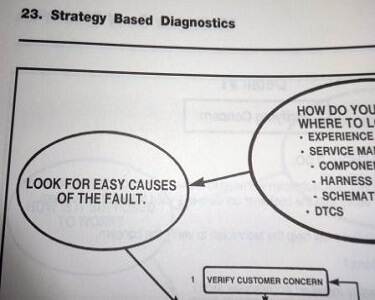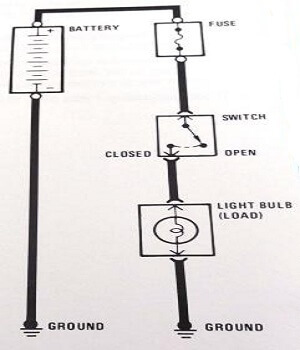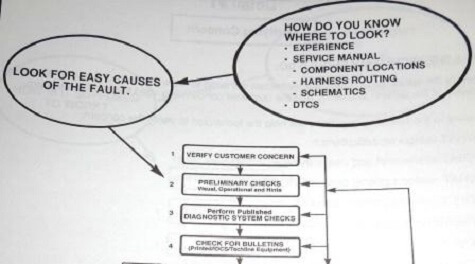Strategy Based Electrical Diagnosis
You need a strategy based electrical diagnosis plan before you approached the vehicle.
This simply means we're going to follow a standard and logical procedure in an effort to uncover the root cause of the automotive electrical problem.
For many do-it-yourself mechanics the first question is where to start. As you can see from the graphic below, we begin with the easiest things to check.
There's a larger full-size strategy based electrical diagnostic image below for your convenience.
In this short article we'll talk about the way professional mechanics approach individual car electrical problems.
These methods stack the odds our favor. In fact, using these steps often uncovers the failure within the first few steps of diagnosis.
Automotive Electrical Text Book: How to Diagnose and Repair Automotive Electrical Systems (Motorbooks Workshop) Paperback.
 Strategy Based Electrical Diagnosis Graphic
Strategy Based Electrical Diagnosis GraphicCheck the Easy Things First
We'll provide an example of a basic circuit below that provides a good representation of the standard automotive electrical system.
We'll test the circuit and see how it operates throughout this article. However, before we head in that direction the place to start is with a good inspection.
As a professional mechanic I can tell you that after identifying the circuit with the malfunction, I've often found the problem just by opening my eyes.
Take a good hard look at the wiring harness that connects the load to the rest of the circuit. In an effort to provide some continuity, pun intended, we'll use the standard automotive electrical horn circuit pictured as an example. The horn speaker is the load of the circuit.
A harness runs from the horn pad switch through the firewall and all the way along the engine compartment where it connects to the horn speaker.
This section of engine compartment wiring provides a major opportunity for damage. In other words, an automotive harness exposed to the elements becomes vulnerable to attack.
Whether it's a mouse or squirrel looking for a snack or a corroded connector the circuit is vulnerable. Look for problems caused by external forces before you break out your automotive voltmeter and wiring diagram.
 Basic Automotive Electrical Circuit
Basic Automotive Electrical CircuitStart at the Electrical Load and Work Back
We need to once again address the question of where to start. One of the most important things about a strategy based electrical diagnosis plan is consistency.
In other words, use the same strategy in every situation calling for electrical diagnosis. This is how a logical step by step process becomes a good habit. Now we can move on to my point.
When you’re dealing with a circuit that has a switch operating a load, start with the load and work backwards toward the switch or power supply. Using the circuit above as an example the horn speaker becomes the most likely suspect.
That doesn't mean that it's always a problem with the horn. However, this component rides just behind the front grille assembly.
It's exposed to extremely harsh conditions such as road salt, rain, sleet and snow. In our example of the horn circuit you can see that the horn is case grounded.
Disconnecting the power to the horn and checking to see if it lights a test light when the horn switch is operated accomplishes two things.
It checks the entire circuit including the fuse, switch, relay and wiring at the same time. If when you activate the switch it lights a test lamp, it tells you that the load has failed.
If it doesn't light the test lamp we’ll start moving through the circuit using our strategy based electrical diagnosis plan.
Testing the Automotive Electrical Circuit
In the provided horn circuit as we start to move back towards the power supply and the switch we come to the horn relay.
This is a key strategic part of this circuit. Before we get into the testing it's time to use another logical diagnostic step.
Operate the horn switch and see if you can hear the relay clicking. If the relay makes this clicking noise it's a sign that the fuse, the switch and the ground remain in good condition.
Take a look at my article about a failed air-conditioning relay for an explanation of how the clicking sound doesn't always represent a good relay.
If you have no power at the horn speaker, yet you have power coming out of horn relay, the problem resides in the wire connecting those two devices.
When you have no power coming out of the relay, electrical diagnosis continues. If the horn relay doesn't operate, we check the fuse, horn switch and the ground to see if any of those components are failing to do their job.
Review of Strategy Based Electrical Diagnosis
In this brief section we'll review what we've learned and I'll link to the video that shows a strategy based electrical diagnosis in action.
I can't stress enough how many times I found what's wrong with the vehicle when I pop the hood and looked at the circuit involved.
I've seen damage from small furry animals, corrosion and even disconnected components from previous repairs.
This happens so many times it's impossible to ignore the likelihood of such malfunctions. With that said, when it comes to the automobile there are two words you can't use. These words are, always and never.
The automobile is quite capable of throwing a curve ball you have never dreamed possible. For this reason you can't say that something is always going to fix a certain problem or you'll never find a bad automotive control module.
However, with a strategy based logical plan of attack you can overcome even those most difficult to find problems.
Now that we've discussed the worst-case scenario take a look at this video that shows the electrical diagnosis plan in action. After you watch the video head back to the automotive electrical repair section of the fix my old ride.com website.
 Diagram of Logical Electrical Diagnosis
Diagram of Logical Electrical DiagnosisAuthor bio : Mark is a retired ASE certified master technician, Chevrolet Professional Service Council member and the founder of FixMyOldRide.com. Watch the video on the about Mark the mechanic page to see his credentials. Mark hand writes all of the articles on FixMyOldRide.com unless indicated otherwise.